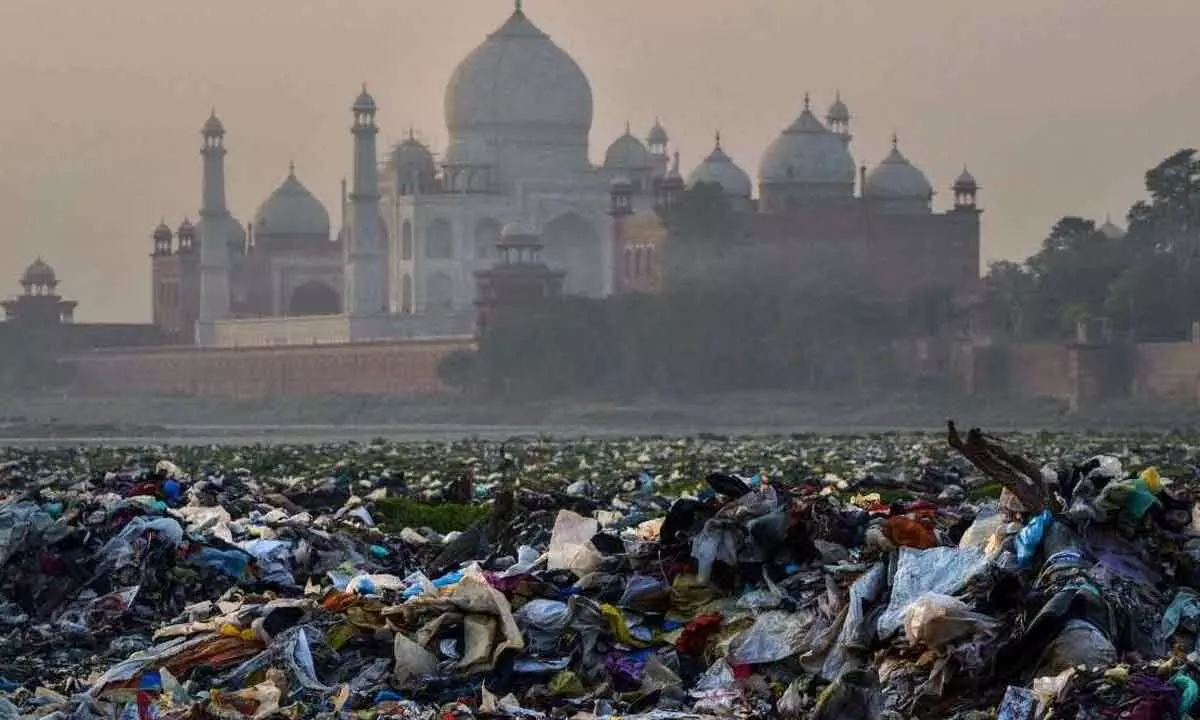Agra’s lifeline stands paralysed
The Yamuna here lies reduced to a drain, far cry from the times when it formed an idyllic backdrop for the splendid 17th-century Taj Mahal
image for illustrative purpose

When voters in the Taj city elected 10 legislators, three MPs, one Mayor, and one district board chairman of the Bharatiya Janata Party in a series of elections, they thought their days of woes and agony would now be over, as in contrast to the earlier governments, the newly elected representatives were grassroots workers and understood the stark reality of life. But the euphoria was short-lived. One by one their hopes were dashed and the long pending demands continued to remain cold-storaged. The international airport which was planned for Agra has now been shifted to Jewar near Noida. The international stadium, the Mughal Museum now rechristened as Chatrapati Shivaji Maharaj Museum, the opening of an agriculture university, the leather park, the IT hub and similar such demands including a bench of the Allahabad High Court, have all been forgotten.
The king of vegetables, potato, now in the dumps due to a price crash, could not be saved as the promised Vodka factory and a Potato Research Institute, could not be promoted. Agra region is the country's largest potato producer. The iron foundries, the glass factories, the handicrafts and the leather shoe units are still waiting for the package of benefits promised in the past. The tourism industry dented heavily during the Covid-19 pandemic period, and continues to remain in the doldrums, as reforms assured have yet to be acted upon.
The most brutal fall back on promises is the Yamuna barrage to store monsoon rains. Yamuna river is virtually dead. "The dry and heavily polluted Yamuna is a clear threat to the Mughal monuments along its banks, including the Taj Mahal," says environmentalist Devashish Bhattacharya. The holy Yamuna river in Braj Mandal (Agra, Mathura, Vrindavan) continues to run dry and polluted, and the promised start of a ferry service from Delhi to Agra for tourists that Union Minister Nitin Gadkiri promised, is nowhere in sight.
An angry green activist Devashish Bhattacharya fumed furiously at the continued callous neglect of the holy Yamuna. "Not only UP Chief Minister Yogi Adityanath, but also Prime Minister Narendra Modi and Union Minister Nitin Gadkiri had promised to take appropriate steps to rejuvenate and revive the ancient glory of Yamuna. Gadkiri on three different occasions had assured that ferries would bring tourists from Delhi to Agra and the Yamuna would be cleaned. But the ground reality continues to remain depressing."
"Yamuna is integral to the Sri Krishna-Radha-lore. For the Hindus, it is one of the holiest rivers. The Bhakti movement poets eulogized Kalindi (Yamuna). Even the Mughal rulers were fascinated by the majestic and resplendent Yamuna river. Almost all great monuments were sited on the banks of river Yamuna from Delhi to Agra," says Goswami Nandan Shrotriya, priest of the 300-year-old Sri Mathuradheesh temple in Agra.
In a series of interventions in the MC Mehta PIL on Taj Mahal pollution, the Supreme Court had stressed not only cleaning pollution but also maintaining a regular flow of water in the Yamuna for the safety of the historical monuments. The National Green Tribunal too has on several occasions ordered an uninterrupted minimum flow of water in Yamuna to cleanse pollutants and support aqua life. But successive governments have lacked the will needed to face the challenge of water pollution in the rivers. To further compound a grave situation, thousands of water bodies in the Braj Mandal have disappeared without a trace. The holy ponds 'kunds' of Braj have either vanished or been grabbed by land sharks, say the locals. "The eco-degradation of the entire Braj Mandal, once known for its green pastures, mangroves, water bodies, and animal life, is a pathetic tale of gross neglect and lop-sided priorities," explains Jagan Nath Poddar, convener of the Braj-Vrindavan Heritage Alliance. Some years ago, responding to a stern high court directive, the Uttar Pradesh government had formed a special force, the River Police in Agra to ensure that people did not pollute the ancient Yamuna river here. Restrictions were also imposed on bathing cattle in the river. Washermen were asked to shift downstream - but to no avail. The multimillion rupee Yamuna Action Plan seems to have gone haywire.
The Yamuna here lies reduced to a drain, far cry from the times when it formed an idyllic backdrop for the splendid 17th-century Taj Mahal. The sad part is that despite alarm raised from time to time, the Union government has so far not been able to draw up a comprehensive National Rivers Policy, nor constitute a Central Rivers Authority. For decades, river activists have been screaming at the top of their voices, pleading with government agencies to release more fresh water in the 1,400-km-long Yamuna to dilute pollution.
Green activists point out that hundreds of dirty drains opening into the Yamuna in Vrindavan, Mathura and Agra continue to pollute the river making the water unfit for human consumption. Just behind the Taj Mahal, garbage dumps have appeared. The Mantola drain, opening into the Yamuna, brings in untreated sewage and toxic waste from slaughterhouses, chain industries, and electroplating units. In Mathura, the Masani drain discharges huge quantities of sewage and wastewater, without treatment. Activists of the River Connect Campaign lament that Agra's lifeline stands paralysed. Sand blasts from the dry Yamuna riverbed also deface the white marble mausoleum of the Taj Mahal eight months in a year.

